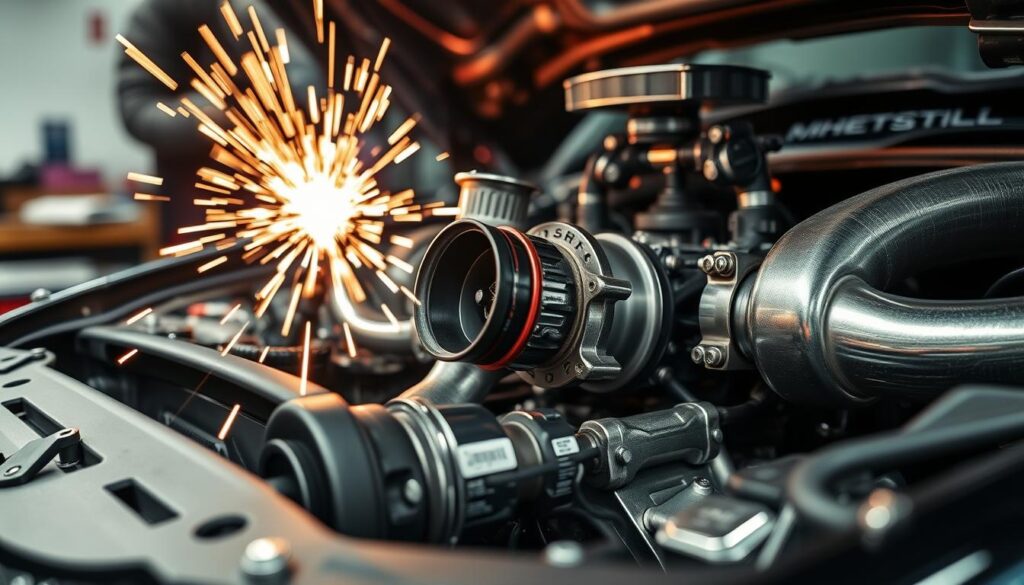Remember the first time you took control of a car? That moment turned the ordinary into something magical. Cars are more than a way to get around for many of us. They bring back memories, dreams, and goals. From making cars out of Legos as kids to experiencing the rush of a track monster, our love for cars is both personal and deep.
Now imagine taking a basic commuter car, one usually ignored for flashier models, and transforming it into a track legend. This is about more than just modifications. It’s the story of every performance upgrade and minute spent tuning in the garage. This transformation from ordinary to extraordinary shows where passion meets creativity. It’s a journey that changes not just a car but also rekindles the adventurous spirit within us.
Key Takeaways
- The transformation story starts with a love for cars from a young age.
- Car enthusiasts often find joy in modifying their vehicles.
- Working on cars independently can lead to significant cost savings.
- The right modifications can turn an ordinary commuter car into a thrilling track machine.
- Choosing cars that are reliable, affordable, and easy to work on is essential for many enthusiasts.
The Evolution of the Everyday Commuter Car
The story of commuter cars begins in car history, focusing on basic transport needs at first. Early models were built to simply move people from one place to another. But as time passed, vehicle design changed a lot because people wanted better fuel efficiency, safety, and comfort.
By the late 20th century, cities grew and people wanted smaller, economical vehicles. Cars like the Honda Civic and Toyota Corolla became very popular for being reliable yet stylish. To meet demands for better fuel use, car companies started to make lighter cars with better designs. This led to big changes in how cars looked and worked.
In the 21st century, caring for the environment made car makers think about hybrid and electric cars. The Toyota Prius, for example, was not just efficient, it also looked unique. This way, the boring old commuter car started to look modern and cool, mixing practicality with style.
This continuous change in car technology and design shows how boring commuter cars can become extraordinary. It opens up new possibilities for even more amazing changes in the future.
The Concept Behind Turning a Commuter into a Track Beast
The idea of turning a normal car into a race car is a big dream for many car lovers. They want to unlock their car’s hidden power. Making a regular commuter car into a racing vehicle needs a special mindset. Car fans look for ways to boost speed, improve handling, and make a driving experience that’s all their own. This idea is key to customizing cars.
Normal commuter cars are not usually made for racing. They have features for comfort that don’t match the excitement of racing. Once you know these limits, you can think of upgrades to turn your car into a racing star. This change isn’t just about better performance. It’s also about showing off creativity and knowledge. You get to improve your mechanical skills and make your car look great too.
The path from a basic commuter to a racing car is very fulfilling. With every change, you make your car fit your way of driving. This makes it look and run better. This journey is exciting for many car lovers. It lets your car show your style. As you get closer to your car, the world of customization gets more thrilling.

From Zero to Hero: How This Boring Commuter Car Became A Track Monster
Turning a regular commuter car into a track beast takes skill, creative thinking, and the best parts. It involves making changes to the car to boost its performance. This adventure shows the major updates and key performance boosts for track greatness. Upgrading your classic hatchback into a track beast may include installing a more powerful engine, upgrading the suspension and brakes, and adding aerodynamic components. These modifications can significantly improve the car’s speed, handling, and overall performance on the track. With the right combination of modifications and a skilled driver behind the wheel, a regular commuter car can be transformed into a competitive track machine.
Key Modifications and Upgrades
The transformation starts with adding aftermarket parts known for boosting durability and performance. Some important car changes include:
- Suspension Kits: High-performance suspension kits improve grip and handling. This lets your modified car turn sharply and accurately.
- Performance Brakes: Better brakes not only help the car stop quicker but also make it safer when driving fast on a track.
- Custom Exhaust Systems: These systems make the engine work better by lowering backpressure. They also create a great sound that makes driving more fun.
Performance Enhancements
The engine is the heart of any track car. Making it better can change how the car feels and drives. Here are some effective upgrades:
- Engine Remapping: Tuning software helps adjust how the engine uses fuel and its timing. This brings out more power and torque but keeps the car reliable.
- Turbochargers and Superchargers: These tools add a lot of power to the engine, making the car speed up faster.
- Aerodynamic Improvements: Things like spoilers and diffusers cut down on wind resistance and increase steadiness at high speeds.
Each upgrade targets specific areas for improvement, such as better lap times and handling. The right modifications not only make the car faster but also more thrilling to drive.

Challenges Faced During the Transformation
Turning a regular car into a race-ready beast comes with its set of challenges. You will face car modification challenges that test your abilities and patience. One tough part is finding the right aftermarket parts. With so many choices, it’s hard to pick parts that fit well and last long.
During your car’s transformation, project complications may pop up when you least expect them. Even simple changes can become complicated if installation problems occur. You might find out the tools you have aren’t enough, causing delays and stress. Also, be prepared for DIY issues like misunderstanding instructions or parts that don’t fit.
It’s challenging to upgrade your car’s performance while following automotive standards. Making sure your car is safe for the track is crucial. This may mean finding creative ways to speed up your car without risking its structure. Stories from other car lovers show how unpredictable and tough these projects can be. Being resilient and good at solving problems is key.

| Challenge | Description | Impact |
|---|---|---|
| Sourcing Parts | Finding compatible aftermarket components | Delays in upgrades, increased costs |
| Installation Issues | Difficulty in fitting parts due to mismatched specifications | Extended timeframes for the project |
| DIY Concerns | Mistakes during modifications can lead to costly repairs | Potential safety hazards |
| Meeting Standards | Ensuring compliance with safety regulations | Increased scrutiny and potential legal implications |
Taking on these challenges as part of transforming your car can improve your skills and bond with your vehicle. Overcoming each obstacle gets you closer to your goal of a dream track car.
The Role of Aftermarket Parts in Making It a Track Day Champion
Turning your daily car into a track star needs the right aftermarket parts. These parts boost track performance and make driving better. It’s important to choose the right ones. Wrong parts can cause problems or not fit your car.
Choosing the Right Components
It’s key to pick aftermarket parts from trusted brands. Make sure the parts match your car’s needs. Things to consider include:
- Compatibility: The parts must fit with your car’s setup.
- Performance Ratings: Look up how well the parts do on the track.
- Durability: Choose parts that can handle track racing’s demands.
Professional versus DIY Modifications
Choosing between expert help or DIY tuning is tough. Each has pros and cons:
| Aspect | Professional Modifications | DIY Tuning |
|---|---|---|
| Quality of Work | Typically high; experts have the know-how. | Depends on your abilities and research. |
| Cost | More expensive due to labor and parts. | Cheaper if you have the tools and know-how. |
| Time Investment | Quicker; experts work fast. | May take longer, especially for newcomers. |
Working with pros can mean better performance from parts, while DIY tuning offers customization and pride. Think about your goals, money, and what you have on hand to choose the right path for your car.

Customer Testimonials and Experiences
Transforming a regular car into a track beast is highly rewarding. Hearing from happy car fans makes it even better. The track car mod community loves sharing their stories. This creates a bond among those who enjoy modifying cars.

Testimonials from car fans tell of a journey full of surprises. Many were doubtful that a regular car could excel on a track. But after modifications, the improved acceleration and handling were beyond their expectations. The thrill they felt on the track was unforgettable.
Customers often talk about more than just speed. They mention the challenges they faced and how they overcame them. Many adjusted their plans after getting feedback on their mods. They worked on their cars, improving parts and learning from every success and failure.
Thrill-seekers enjoy talking about their track experiences. They discuss their laps and the friendships they’ve made with other enthusiasts. These conversations show a deep love for performance driving, not just owning a car.
Turning a normal car into a track star is a journey of personal growth. Each story reminds us of the joy in the process. It’s about the thrill of the drive and seeing your dream car come to life.
Conclusion
An average car can turn into something amazing. This shows the power of creativity and skill in car culture. From doubt to triumph, it’s a journey fueled by passion.
Each modification shares an inspiring story. It’s about people and cars working together for something great.
The path to a race-ready car is full of challenges and new ideas. It’s about pushing limits while keeping safe. This story is an invite to dive into the car enthusiast world.
See how your car can start on this exciting path too.
This story pushes us to join the car modification community. Whether new or experienced, there’s a place for everyone. Dare to join, and add your story to this passionate world.










